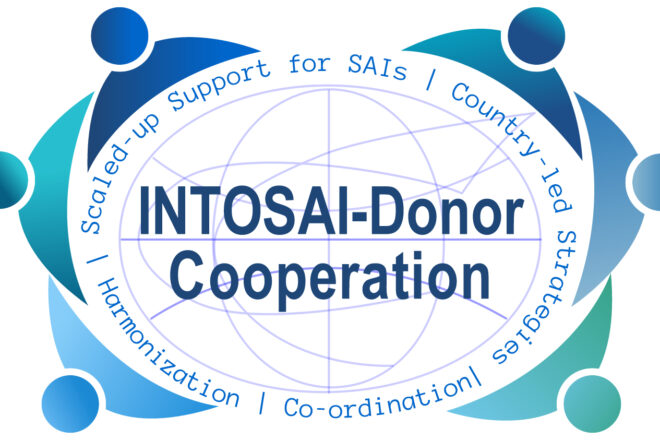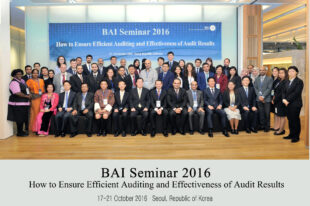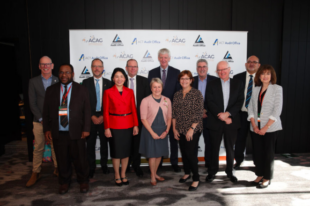INTOSAI-Donor Cooperation Relaunches GCP

SPOTLIGHT ON SUCCESS
Working with Supreme Audit Institutions is important in making a difference in the lives of citizens. How do we communicate this importance to stakeholders? How do we convey the significance of funding and supporting SAIs?
The INTOSAI-Donor Cooperation is taking steps towards this objective through a stronger focus on measuring results and sharing these results in success stories.
In 2016, the INTOSAI-Donor Cooperation (Cooperation) decided to update the organization’s strategic direction. As a result, the Cooperation is now entering a new phase with an increased focus on results measurement and communication. In relation to this new results framework, a Communications Strategy has been developed, which encompasses objectives to maintain Cooperation support by raising awareness on the Cooperation’s value and to influence behavioral changes to ensure the objectives of the INTOSAI-Donor Memorandum of Understanding (MoU)are achieved.
One of the key activities is the development of success stories to better:
- Share results accomplished through the combined efforts of INTOSAI and Donor communities in strengthening SAI performance
- Illustrate how these joint efforts have had an impact on the lives of citizens
- Demonstrate how the MoU principles contributed to these results.
The success stories will be based on evidence—the work is closely related to results measurement where the Cooperation seeks to objectively measure changes in SAI performance over time.
The Cooperation, with support from the United States Government Accountability Office (GAO), has already collaborated with SAI Bhutan (RAA), SAI Sierra Leone (ASSL) and the PASAI Secretariat for the creation of three success stories, all of which have a country-level focus. Key achievements are illustrated in the figure below.
While the PASAI chronicle is based on a regional capacity development program, its primary focus is on the concrete results in SAI Kiribati and SAI Tuvalu. The stories, first made publicly available during the XXII Congress, have now been published on the Cooperation website.
The Cooperation has defined three criteria that need to be in place:
- Enhanced Internal Capacity
- External Impact
- Contribution of INTOSAI-Donor MoU principles
Enhanced Internal Capacity. The success stories associated with SAI Bhutan, SAI Sierra Leone, SAI Kiribati and SAI Tuvalu all include enhanced internal capacity and improved audit quality experiences. Dasho Tshering Kezang, Auditor General of SAI Bhutan, noted, “External support has been instrumental in enhancing the institutional capacity of our audit office.”
External Impact. Internal improvements must also translate externally. In Bhutan, increased audit quality has influenced Bhutan’s public debt management. Based on audit recommendations, the Ministry of Finance (MOF) developed a Public Debt Policy that provides a single overall threshold, as well as sector-specific thresholds for external debt.
Shortly after the policy’s implementation, the MOF established a new department of Macroeconomic Affairs, whose mission is to “maintain a sustainable level of public debt.” In Sierra Leone, capacity development programs have led to a strengthened relationship between the SAI and the Public Accounts Committee (PAC) resulting in improved parliamentary scrutiny of audit reports, public access to the SAI’s reports and publicly broadcast PAC hearings.
Additionally, the prompt audit of the 2015 Management of Ebola Resources and the resulting report on mismanagement and corruption in the use of Ebola aid funds led to strong debates among stakeholders and increased pressure for accountability.
Increased capacity in the SAIs of Kiribati and Tuvalu, both in the PASAI region, has driven timely completion of the whole of government audits, positively contributing to the availability of up-to-date and reliable financial information for the respective governments in preparing budgets and formulating relevant policies.
Mr. Eli Lopati, Auditor-General of SAI Tuvalu, stated, “The Sub-regional Audit Support (SAS) program has contributed to increased trust by our clients in the reports we deliver.”
The ultimate goal is to demonstrate concrete effects on the lives of citizens, a challenging task particularly due to the Cooperation having only been established in 2010. However, we believe showcasing the external impact already achieved can affect the lives of citizens in the long run.
Contribution of INTOSAI-Donor MoU Principles. The PASAI story provides a good example of regional support aligned behind a regional strategic plan, leading to coordinated and harmonized cooperation. Both the Bhutan and Sierra Leone stories illustrate SAI-led support, with donor sponsorship backing the SAI strategic plans, subsequently enhancing SAI capacity.
Where possible, the Cooperation’s regional and global initiative influence toward these results will also be highlighted, such as the project stemming from the SAI Capacity Development Fund, the Global Call for Proposals, or that the SAI Capacity Development Database was used to ensure effective coordination with other partners.
While this is not an absolute requirement, the goal is to have an all-inclusive development of narratives that recognize successes that have come, in part, as a result of united stakeholders coming together working for a common goal (the essence of the INTOSAI-Donor Cooperation).
The positive developments are inspiring! Yet, the coming years will still be challenging for SAI Bhutan, SAI Sierra Leone, SAI Kiribati and SAI Tuvalu as they continue the journey in relation to performing audits in accordance with international standards and making those changes sustainable.
Mrs. Lara Taylor-Pearce, Sierra Leone’s Auditor General, echoes these sentiments and has “embraced the sustained support given by our development partners and harmonized development programs with our strategic plans. We hope the intense development assistance to ASSL can continue until we reach a level of matureness where we can make an impact based on our own sustainable capabilities.”
In the coming years, these success stories will be widely distributed using a number of forums, and the Cooperation will continue developing new ones as cooperative projects and associated efforts progress to completion. The forums include the current Website, as well as the new Cooperation Portal (planned for launch later this year). A new Portal feature will be SAI country sites—a great place for SAIs to demonstrate their work, the support they have received from others and how this is making an impact on society.
In light of the current challenges the world is facing, now, more than ever, it will be important to find effective ways to communicate to stakeholders that working with SAIs is important, makes a difference to the lives of citizens, and should be funded and supported.
Globally, reduced economic growth, tremendous investment needs to meet the Sustainable Development Goal objectives, rising inequality within the developing world and enduring corruption, greatly impact society. Though these factors can potentially lead to a lack of appropriate funding to SAIs and may hinder SAI ability to deliver on mandates, it is important to note that they also enhance the central role of the SAI in the Public Financial Management system of a country.
Making effective use of scarce resources, identifying improvement opportunities, holding the government accountable and promoting transparency are just a few examples of how SAIs can contribute. For a more in depth article about the important role of SAIs, see the Cooperation update in INTOSAI Journal Summer Issue 2016.
The INTOSAI-Donor Cooperation Secretariat is always seeking examples of SAI capacity development success stories that can potentially be developed into communications pieces. If you wish to share examples, please email the Secretariat at intosai.donor.secretariat@idi.no.





